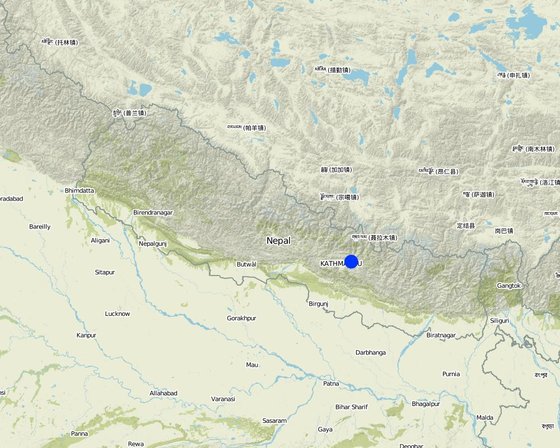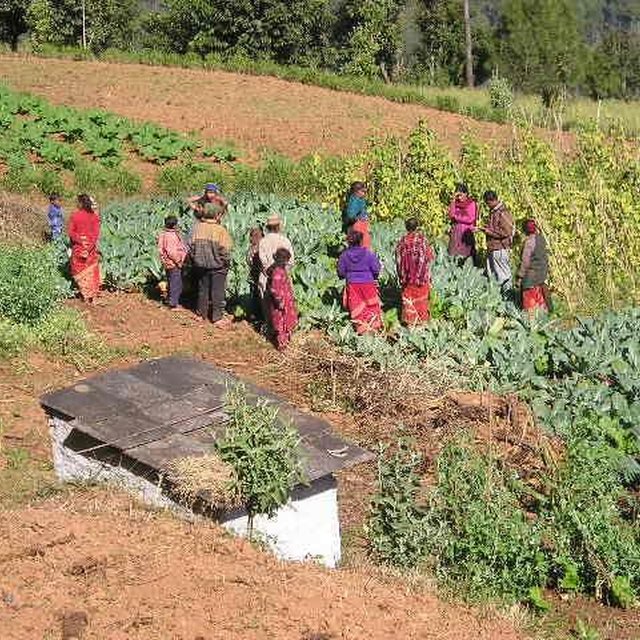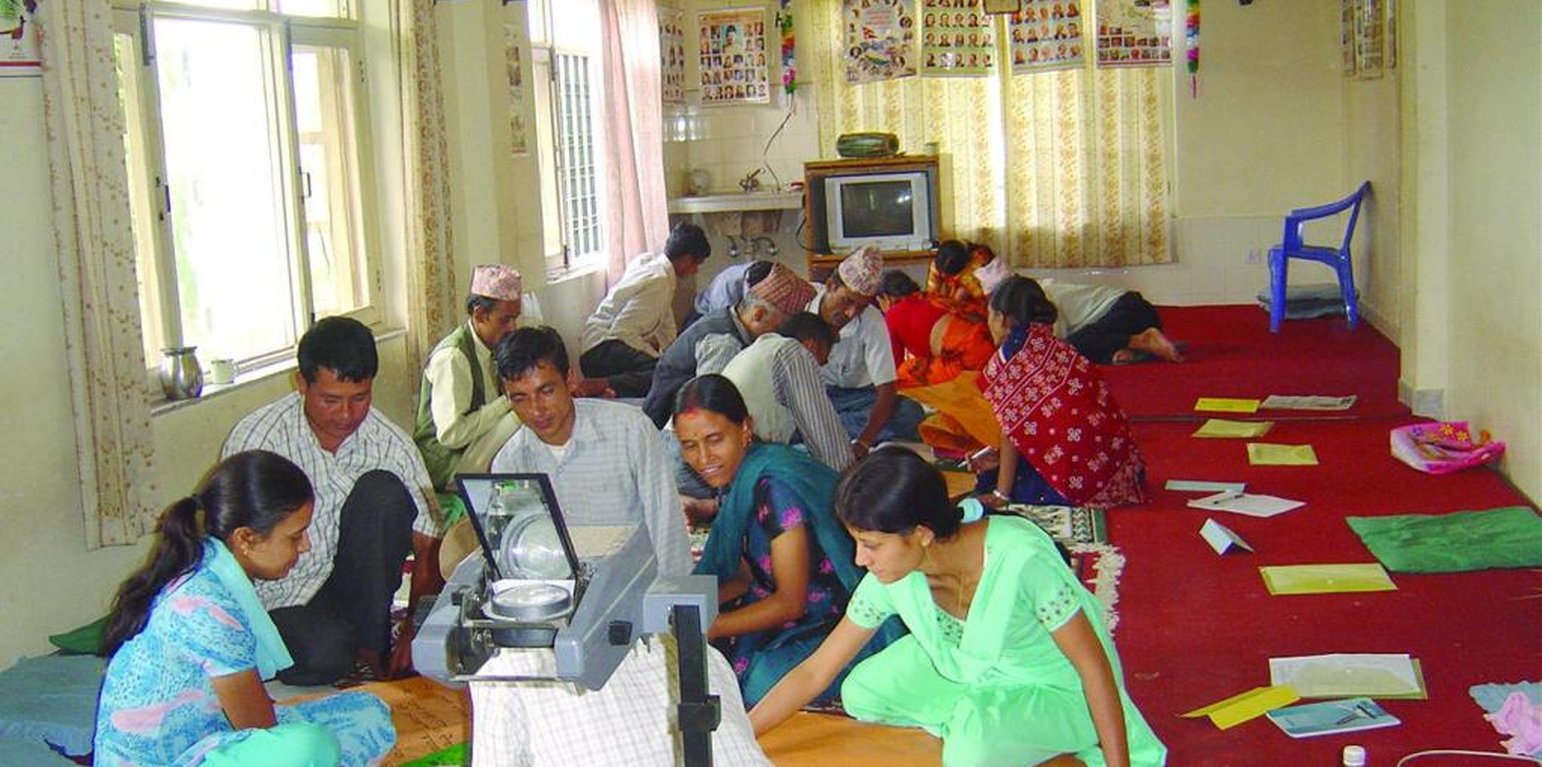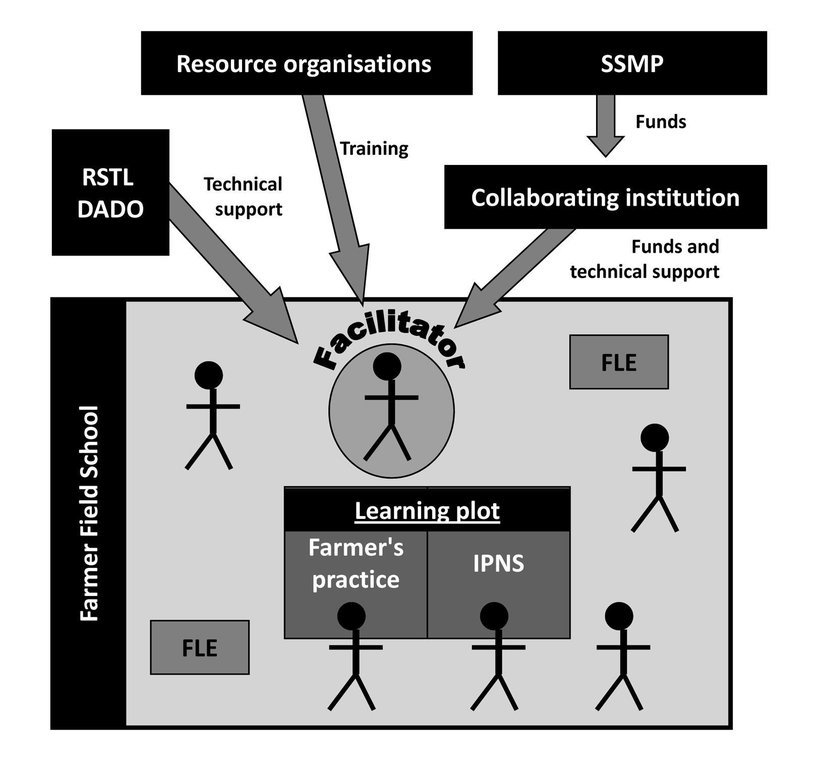Farmer field schools on integrated plant nutrient systems
(Népal)
Krishak Pathsala (Nepali)
Description
Participatory and collaborative learning through the farmer field school approach
There are different ways of carrying out agricultural extension. Farmer field schools represent a participatory approach that directly reaches farmers and addresses their day-to-day problems. The concept of farmer field schools builds on the belief that farmers are the main source of knowledge and experience in carrying out farm operations, in contrast to conventional top-down approaches that place most value on scientists' findings. The term 'farmer field schools' came from the Indonesian expression 'sekolah lapangan' which means 'field school'. It is a group based learning approach, which brings together concepts and method of agro-ecology, experiential education, and community development. The first field schools were established in 1989 in central Java when 50 plant protection officers tested and developed field training methods as part of an integrated pest management (IPM) training of trainers course. Two hundred field schools were established in that season involving 5,000 farmers. The following season, in 1990, an additional 45,000 farmers joined field schools run by 450 crop protection officers.
The same approach is being used in Nepal's integrated pest management programme. Several consultation meetings and workshops were held at national level to put the integrated nutrient management concept into practice. These meetings led to farmer field schools being recognised as an appropriate approach for putting this concept into practice. The approach was piloted in 2000 and 2001 and fully initiated in 2002 when 32 farmer field schools were run with support from SSMP. As far as SSMP knows, farmer field schools on integrated plant nutrient systems have been run since SSMP's involvement. The Government of Nepal's National Fertiliser Policy now recognises integrated plant nutrient systems as a concept to improve the efficient use of different nutrient inputs, and farmer field schools as an appropriate technology and extension approach for soil and plant nutrient management in Nepal. So far some 226 farmer field schools have been run in Nepal on integrated plant nutrient systems reaching more than 5,000 households.
Lieu

Lieu: Midhills, Népal
Géo-référence des sites sélectionnés
Date de démarrage: sans objet
Année de fin de l'Approche: sans objet
Type d'Approche
-
traditionnel/ autochtone
-
initiative/ innovation récente locale
-
fondé sur un projet/ programme

Farmers observing a caulifl ower plot during a regular farmer field school session (Steffen Schulz)
Objectifs de l'approche et environnement favorable
Principaux objectifs de l'Approche
Transfer of technology to farmers on soil and plant nutrition management. Empowerment of farmers. Production of healthy crops without negative environmental effects.
The SLM Approach addressed the following problems: Lack of effective and efficient ways of transferring technologies to farmers. Conventional approach of technology transfer, where farmers are believed to have poor knowledge and skills. Farmers are always perceived as a recipient of technology and knowledge
Conditions favorisant la mise en oeuvre de la/(des) Technologie(s) appliquée(s) sous l'Approche
Conditions entravant la mise en oeuvre de la/(des) Technologie(s) appliquée(s) sous l'Approche
-
Normes et valeurs sociales/ culturelles/ religieuses : Group: unintegrated, less organised group
-
Connaissances sur la GDT, accès aux supports techniques: Soil-fertility management, plant nutrient dynamics
-
Autre: Extension: Top-down, technology-centred, not farmer-centred
Participation et rôles des parties prenantes impliquées dans l'Approche
Parties prenantes impliquées dans l'Approche et rôles
| Quels acteurs/ organismes d'exécution ont été impliqués dans l'Approche? |
Spécifiez les parties prenantes |
Décrivez le rôle des parties prenantes |
| exploitants locaux des terres / communautés locales |
|
|
| Spécialistes de la GDT/ conseillers agricoles |
|
|
Participation des exploitants locaux des terres/ communautés locales aux différentes phases de l'Approche
aucun
passive
soutien extérieur
interactive
auto-mobilisation
initiation/ motivation
Participatory approach: group discussions involving all local stakeholders
planification
Orientation workshop involving all stakeholders - farmers participation is crucial
mise en œuvre
Farmers are the key actors with trained staff of collaborating institutions (CI) facilitating the process
suivi/ évaluation
Farmers evaluate and monitor jointly on a regular basis
Research
Farmer-led experimentation based on local needs and context
Diagramme/ organigramme
Farmer field schools are usually facilitated by a field staff member of a collaborating institution and funded by SSMP. The facilitators are supported technically by the regional soil testing
Prises de décision pour la sélection de la Technologie de GDT
Les décisions ont été prises par
-
les exploitants des terres seuls (auto-initiative)
-
principalement les exploitants des terres soutenus par des spécialistes de la GDT
-
tous les acteurs concernés dans le cadre d'une approche participative
-
principalement les spécialistes de la GDT, après consultation des exploitants des terres
-
les spécialistes de la GDT seuls
-
les responsables politiques/ dirigeants
Les décisions ont été prises sur la base de
-
l'évaluation de connaissances bien documentées en matière de GDT (prises de décision fondées sur des preuves tangibles)?
-
les résultats de recherches?
-
expériences et opinions personnelles (non documentées)
Soutien technique, renforcement des capacités et gestion des connaissances
Les activités ou services suivants ont fait partie de l'approche
-
Renforcement des capacités/ formation
-
Service de conseils
-
Renforcement des institutions (développement organisationnel)
-
Suivi et évaluation
-
Recherche
Renforcement des capacités/ formation
La formation a été dispensée aux parties prenantes suivantes
-
exploitants des terres
-
personnels/ conseillers de terrain
Formats de la formation
-
sur le tas
-
entre agriculteurs (d'exploitants à exploitants)
-
zones de démonstration
-
réunions publiques
-
cours
Sujets abordés
A training of trainers course is provided to selected staff from the collaborating institutions who have been involved substantially in agriculture development and farming practices activities. Seven days basic training on integrated plant nutrient systems and farmer field schools is provided. There is provision for a sharing forum at district level based on the demand of staff involved in conduc
Renforcement des institutions
Institutions ont été renforcées ou mises en place
-
non
-
oui, un peu
-
oui, modérément
-
oui, beaucoup
Décrivez l'institution, ses rôles et responsabilités, ses membres, etc.
Type de soutien
-
financier
-
renforcement des capacités/ formation
-
équipement
Plus de détails
Local level organisations are involved in carrying out the farmer field schools. Local institutions are supported financially and technically by SSMP. The major aim of this approach is to build local
Suivi et évaluation
socio-cultural aspects were regular monitored through observations; indicators: status
bio-physical aspects were regular monitored through measurements; indicators: nitrate, nitrogen, pH, organic matter, P and K, yield measurements
technical aspects were regular monitored through observations; indicators: cash income
economic / production aspects were regular monitored through observations
Recherche
La recherche a traité les sujets suivants
-
sociologie
-
économie/ marketing
-
écologie
-
technologie
It is difficult to compare results if many treatments are applied at the same time in a plot. Therefore, it is always advised that component trials are run for different treatments. Such trials make for easier understanding of the different treatments and enable farmers to see the effects of particular treatments.
Financement et soutien matériel externe
Budget annuel en dollars US de la composante GDT
-
< 2 000
-
2 000-10 000
-
10 000-100 000
-
100 000-1 000 000
-
> 1 000 000
Precise annual budget: sans objet
Approach costs were met by the following donors: local government (district, county, municipality, village etc) (participants): 20.0%; other (development project): 80.0%
Les services ou mesures incitatives suivantes ont été fournis aux exploitants des terres
-
Soutiens financiers/ matériels fournis aux exploitants des terres
-
Subventions pour des intrants spécifiques
-
Crédits
-
Autres incitations ou instruments
Analyses d'impact et conclusions
Impacts de l'Approche
Non
Oui, un peu
Oui, modérément
Oui, beaucoup
Est-ce que l'Approche a aidé les exploitants des terres à mettre en œuvre et entretenir les Technologies de GDT?
Attendance at farmer field schools has led to many farmers adopting practices that have improved the fertility status of their soils and have increased crop productivity. Most of these farmers have realised the need for the judicious use of local and external resources to increase crop production
Principale motivation des exploitants des terres pour mettre en oeuvre la GDT
Durabilité des activités de l'Approche
Les exploitants des terres peuvent-ils poursuivre ce qui a été mis en oeuvre par le biais de l'Approche (sans soutien extérieur) ?
Capacity remains at the local level so that farmers are able to run farmer field schools themselves.
Conclusions et enseignements tirés
Points forts: point de vue de l'exploitant des terres
Points forts: point de vue du compilateur ou d'une autre personne-ressource clé
-
Farmers are the source of knowledge; farmers adopt technologies based on their context (How to sustain/ enhance this strength: Involve farmers in a more participatory way)
-
Participatory approach
-
Farmers decide the pace of implementation and what should be done
-
The schools stress the importance of using local resources to reduce dependency on external resources
-
Increased effi ciency and effectiveness of local resources use
Faiblesses/ inconvénients/ risques: point de vue de l'exploitant des terrescomment surmonter
Faiblesses/ inconvénients/ risques: point de vue du compilateur ou d'une autre personne-ressource clécomment surmonter
-
Farmer field schools need time and their costs are higher than other similar approaches
-
Non-technical staff are often involved in carrying out farmer field schools
Ensure capacity building and regular sharing forums
Références
Date de mise en oeuvre: 19 janvier 2009
Dernière mise à jour: 28 juin 2017
Personnes-ressources
-
Richard Allen (richkga@gmail.com) - Spécialiste GDT
-
Soil Management Directorate - Spécialiste GDT
-
Team Leader Sustainable Sustainable Soil Management Programme (SSMP) (ssmp@helvetas.org.np) - Spécialiste GDT
Description complète dans la base de données WOCAT
Données de GDT correspondantes
La documentation a été facilitée par
Institution
- HELVETAS (Swiss Intercooperation)
Projet
- Sustainable Soil Management Programme, Nepal (SSMP)
Références clés
-
Paudel, C.L.; Regmi, B.D.; Schulz, S. (2005) 'Participatory Innovation Development - Experiences of the Sustainable Soil Management Programme in Nepal:
-
SSMP (2003) Introduction to Integrated Plant Nutrient Systems (in Nepali). Kathmandu: Sustainable Soil Management Programme: SSMP
-
In Kolff, A.; van Veldhuizen, L.; Wettasinha, C. (eds) Farmer Centred Innovation Development ???? Experiences and Challenges from South Asia, pp. 109-126. Bern: Intercooperation: SSMP






